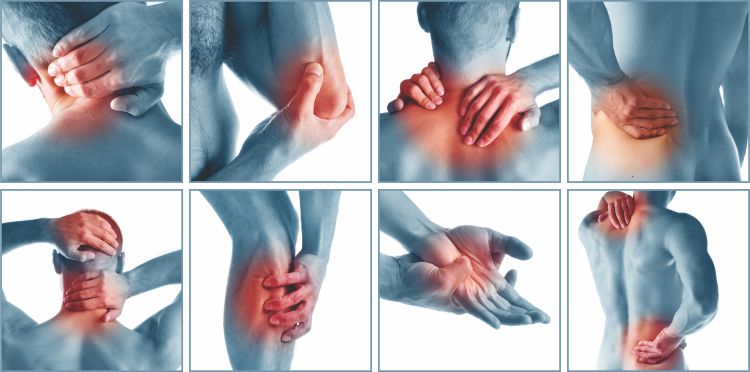Approach to body pain syndrome

In fact, complaining of body pain in day to day practice is common, it is mostly seen in women aged above 50 years. These patients are habituated to take pain killers and other modes of treatment. But even though it is difficult to pinpoint the reasons for Muscular skeletal pain, the doctor should have a systematic approach to the common problems. Hence, always a systematic approach to the Muscular skeletal pain can justify the patient’s need. Instead of giving pain killers, if we have a systematic approach which can prevent adverse effects of pain killers. For example Acidity, Renal failure, Hypertension etc.
Etiology of pain
- Lack of sleep
- Excessive working hours
- Hypothyroidism
- Systemic Lupus Erythematosus(SLE)
- Hyperuricemia
- Arthritis of Joints
- Drugs(Statins)
- Muscle Spasm
- Hyponatremia
- Entrapment of nerves
- Complex regional pain syndrome
- Myofascial pain syndrome
- Fibromyalgia
- Polymyalgia rheumatica
- Chronic pelvic pain syndrome
- Somatic symptom disorder
Eliminating aggravating factors
For Example:
- Lack of sleep
- Restrict excessive daily work at home
- Maintain good sitting posture
- Exclude stress conditions
- Exclude any drugs causing muscle pain, ex: Lipid-lowering drugs
- Maintain a minimum of 8 hours of sleep per day.
Eliminating systemic diseases
For example: Hypothyroidism, Hyperuricemia, SLE(Systemic Lupus Erythematosus) and occult cancers. These conditions cause pain especially occur during night time. Lower back pain, which is not relieved with rest can be seen in Prostate, lung, breast metastasis). We need to explain the illness to the patient, This may relieve anxiety related pains. We need to explain pain relief strategies, for example walking, basic stretching exercises etc..
The concept of applying heat or cold for pain relief
Sometimes, even doctors also get confused about whether to apply heat or cold modalities for musculoskeletal disorders. But there is a differentiation between cold and heat modality.
When to apply hot packs or hot water bottles?
Whenever there is a muscles spasm associated with pain, we have to apply hot packs so that we create an analgesic effect on free nerve endings. So that pain associated muscles spasm is decreased. Hence pain will be decreased.
When should we apply Ice packs?
If there is any inflammation-associated pain without muscle spasm should apply ice packs. So that decreased blood supply leads to decreased local metabolism leads to decreased swelling and pain.
Individual specific pain syndromes orientation
Fibromyalgia:
Fibromyalgia(FM) is a common cause of chronic widespread musculoskeletal pain, often accompanied by fatigue, cognitive disturbance, and psychiatric symptoms. The aetiology of the syndrome is unknown. Despite symptoms of soft tissue pain affecting the muscles ligaments and tendons, there is no evidence of tissue inflammation.
Clinical manifestations:
Fibromyalgia is a common cause of widespread musculoskeletal pain in women ageing between 20- 55 years. Typically patient complaining of generalised pain as they are suffering from viral fever.
It is associated with Fatigue especially when arising from sleep even though they slept for 8 to 10 hours, they feel unrefreshed.
They have cognitive disturbances, because of that, they are unable to perform the task which requires rapid thought changes. It may be associated with depression, anxiety and headache.
How to Diagnose:
- We need to check the clinical history
- By excluding other causes and side effects
- The positive tender points must be at least
11 out of 15.
Myofascial pain syndrome
It is not widespread pain condition like Fibromyalgia and apart from that, another differentiating feature is trigger points unlike tender points in Fibromyalgia in these points cannot cause local tenderness they can cause pain, sensory symptoms and muscle contraction distinct from the trigger point that is called trigger zone. These trigger points are present within the muscles in the pelvis these trigger points can be stimulated by various points of the patient. Hence patient can be presented with back pain associated with urogenital symptoms with negative urine culture reposts and normal ultrasound abdomen reports from various doctors and clinics. That is called chronic pelvic pain syndrome.
Polymyalgia Rheumatica
Unlike Fibromyalgia and Myofascial pain syndrome, it is not widespread and it is not localised pain condition.There are no trigger and tender points. In this condition shoulder girdle(neck muscles, shoulder muscles) and hip girdle(Pelvic muscles and thigh muscles) are involved and in this condition not only the aching sensation of the muscles but also stiffness more than 30 mins especially in early morning or after an inactive period. These pains and stiffness are very well responded within 5 days after starting steroid therapy. It is associated with a headache due to giant cell arteritis apart from these increased ESR and CRP is seen.
Complex regional pain syndrome
After a fracture or soft tissue trauma, within 4-6 weeks disproportionate of time and degree of trauma, the patient gets regional pain associated with skin and sensory abnormalities This is sometimes seen even without an identifiable trigger, which is seen mostly in upper lives. Previously it is called as “Reflex Sympathetic Dystrophy”.
Lumbar spinal stenosis
Due to Ligamentum flavum or Protrusion of an intervertebral disc of lumbosacral region cab be occurred. Due to this patient may get pain at lower back and sometimes extends to the buttock and sometimes below the Knee joint. Lumbar canal volume decreases with the backward extension of the body. Hence these patients complaint about more back pain while walking down. Sometimes this condition causes aching sensation and numbness.
Thoracic outlet syndrome
Due to the compression of Vascular component, the patient may get the pain over a week. The pain will get radiated from shoulder to head. This is usually caused by Cervical rib. But most often it is caused by sagging of shoulder girdle resulting from ageing, obesity and pendulous breast.
Arthritis
The inflammation of joint is called as Arthritis. This condition is of two types – Osteoarthritis and Inflammatory arthritis. Arthritis occurs due to connective
tissue disorders. Osteoarthritis is due to the ageing process, it usually serves if the patient is doing activities and decreases during the resting period. But Inflammatory arthritis is usually nerve severely in the form of swelling and pain during early morning atleast more than 1 hour. This is called early morning stiffness. Whereas Arthritis occurs only in the aged population but inflammatory arthritis occurs at any age.
Brucellosis
It is a bacterial infection. Osteoarticular involvement is the most common presentation. In this condition, the patient complains back pain and sometimes neck pain.

Conclusion
As most of these diseases don’t have a specific diagnostic test to diagnose any specific condition and overlapping of symptoms among these diseases cause the difficulty in diagnosis. Hence, proper questioning of the patient, counselling of patient and proper treatment by the doctor is the only way to get diagnose and get rid of symptoms.

Dr B Jaipal Reddy
Consultant Physician
(General Medicine, Diabetology)
Omni Hospitals- Kothapet
